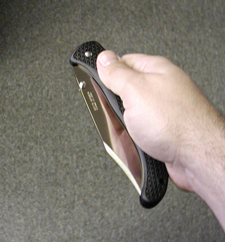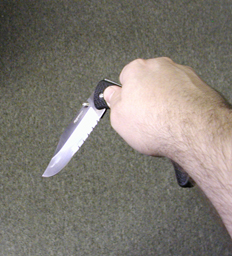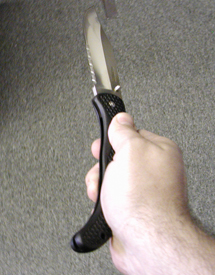its paid sponsors, whose products you need!
“Stay ‘unreasonable.’ If you don’t like the solutions
[available to you], come up with your own.”
Dan Webre
The Martialist does not constitute legal advice.
It is for ENTERTAINMENT PURPOSES ONLY.
Copyright © 2003-2004 Phil Elmore, all rights reserved.
The Folder Wrist Snap
By Phil Elmore
DISCLAIMER: USING A KNIFE IS INHERENTLY DANGEROUS.
The Martialist disclaims all
liability for accidents that occur while working with knives. Train
safely with appropriate equipment, including dull training knives where
applicable.
Any folding knife — regardless of whether it has a thumb stud,
thumb hole, or other means of one-hand opening — can be opened with one hand by
taking advantage of
centripetal
force. That’s a fancy way to say that you can snap your wrist hard and
make the blade snap into place.
It was during my college days that my friend Jay, a
self-described redneck from rural Ohio, first taught me to open a lockback
folder using the wrist snap. (It was Jay who first taught me to carry a
boot knife inside the waistband of my pants rather than in my boot, too.)
He was using the plastic-handled version of the Buck 110 (this was before
one-handed tactical folders were well known), which required a tremendous amount
of force to open with wrist action only. He performed the move without
fail, though — and so I learned to do so, too.
When I read
Michael Janich’s
Street
Steel: Choosing and Carrying Self-Defense Knives,
I was delighted to see the wrist snap illustrated in it. The book is an
excellent one that describes things a lot of “knife people” take for
granted. It’s a must-have for those new to blades.
To perform the wrist snap, follow these
instructions. If you are left-handed, simply mirror the movements here.
Step 1: Grasp the folding knife as hard as you can
to keep it from flying out of your grip. You must use the pressure of your
fingers to retain the knife because you can’t take a true grip on it. Your
fingers must be clear of the blade so they will not intercept its arc as it
opens.

Step 2: Snap your wrist in a tight circular arc counter-clockwise.
If you were to stop moving after this step, you’d probably find the blade
half-open and pointing at a right angle to your wrist. On some very loose
folders, this action alone is enough to snap the blade in place, but don’t count
on that happening.

Step 3: Snap your wrist in a tight circular arc clockwise.
The blade will open the rest of the way and snap in place. Once this
movement is complete, shift your thumb to take a proper grip on the handle.

Practice this until you can perform it in a single, smooth
motion rather than in two discrete jerks.
The wrist-snap is not subtle and will startle people who fear
knives because it can make any knife (particularly those that are very loose
when closed) look like a switchblade. Snapping a knife open in this manner
also increases wear and tear on the locking mechanism, as parts that lock into
place when the knife is simply thumbed open are slammed into each other when it
is wrist-snapped open.
From a “tactical” perspective, the wrist-snap has
other liabilities. Making too wide and open a motion leaves you vulnerable
during the snap. Snapping with the arm extended too far from the body
leaves you similarly vulnerable during the motion. There is also the
chance that, despite exerting all the pressure you can, you could snap your
knife right out of your hand.
My friend Jay first learned to do the wrist snap because his
lockback had no other means of one-hand opening. Working on a campground,
he frequently found himself in the field needing to deploy his knife while his
other hand and arm were occupied.
The wrist-snap is a great skill
to have in case you find yourself in similar need — be it in the field or on
the street.
